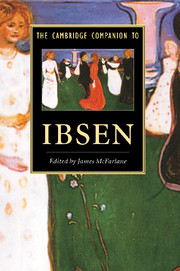Book contents
- Frontmatter
- 1 Ibsen's dramatic apprenticeship
- 2 Ibsen and historical drama
- 3 Dramatic and non-dramatic poetry
- 4 Ibsen and comedy
- 5 Ibsen and the realistic problem drama
- 6 Ibsen and feminism
- 7 The middle plays
- 8 The last plays
- 9 Ibsen's working methods
- 10 Ibsen and the theatre 1877-1900
- 11 Ibsen and the twentieth-century stage
- 12 Ibsen on film and television
- 13 On staging Ibsen
- 14 Ibsen and the drama of today
- 15 A century of Ibsen criticism
- 16 Works of reference
- Index
2 - Ibsen and historical drama
Published online by Cambridge University Press: 28 May 2006
- Frontmatter
- 1 Ibsen's dramatic apprenticeship
- 2 Ibsen and historical drama
- 3 Dramatic and non-dramatic poetry
- 4 Ibsen and comedy
- 5 Ibsen and the realistic problem drama
- 6 Ibsen and feminism
- 7 The middle plays
- 8 The last plays
- 9 Ibsen's working methods
- 10 Ibsen and the theatre 1877-1900
- 11 Ibsen and the twentieth-century stage
- 12 Ibsen on film and television
- 13 On staging Ibsen
- 14 Ibsen and the drama of today
- 15 A century of Ibsen criticism
- 16 Works of reference
- Index
Summary
In 1873 - close to the mid-point of half a century of creative authorship - Ibsen published the drama which he himself regarded as his 'hovedvserk', his 'main work' or masterpiece: Emperor and Galilean. It was not to be a historical drama of the merely traditional kind. Ibsen's choice of subtitle - 'a world-historic drama' - betrayed his ambitions.
It was a vast historical canvas which he then unfolded, much broader than that of any of his earlier dramas. Years of painstaking labour, including the close study of historical sources, went into this evocation of characters and events from a distant past: the Roman Empire of the fourth century AD and the last twelve years of the life of Julian the Apostate.
Ibsen himself admitted in his correspondence [iv, 603-9]x that the historical material he had been grappling with was enormous, and that he realized that he had sacrificed years of his life to this mammoth work, a 'double' drama in ten Acts. To call forth this historical epoch had been 'a Herculean task'. Nevertheless he was persuaded that he had succeeded in re-creating these historical characters in 'realistic' form. This had however not been his main concern: his perspective of history here had been — to use Nietzsche's terminology — neither antiquarian nor monumental.
- Type
- Chapter
- Information
- The Cambridge Companion to Ibsen , pp. 12 - 27Publisher: Cambridge University PressPrint publication year: 1994
- 2
- Cited by



